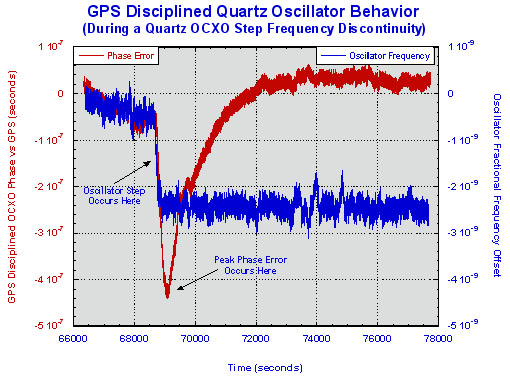Frequency Steps

No Frequency Steps - Guaranteed
We carefully specify the crystals that we use in our oscillators, and source them from one of the oldest crystal companies in existence. Then we monitor our finished oscillators continuously for at least 30 days. This is an expensive process, but it is the only way to guarantee that our Meridian II, Tycho II, RTM3205, and Ninja quartz-based products are free of frequency steps.
The Art of Making Quartz Crystal Oscillators
The fabrication of precision quartz crystals for oscillator applications is a highly developed art. Each manufacturer guards the details of their process carefully. The process begins with the growing of the quartz crystals, which is followed by slicing them into blanks and then contouring them, which is then followed by mechanically and chemically lapping/polishing them. Finally the electrodes are plated to the two surfaces and then mounted in the holder. At all steps of the process, there are choices to be made in the best ways to do them. Some manufacturers are much better than others.
Most Quartz Crystal Oscillators Exhibit Frequency Steps
One of the most common and troublesome flaws, even in precision crystals, is the presence of sudden shifts in the oscillating frequency, called a frequency step. The reasons for this behavior are not universally known, though there are many theories. In our experience with high-stability-quartz oscillators, there are possibly two or three manufacturers who have developed techniques for minimizing this behavior in their crystals.

Frequency steps can be quite large (several parts per billion). When they occur in a GPS-disciplined application, the outputs from the instrument instantly depart from the UTC timescale at this rate. Only after several minutes (possibly up to 1/2 hour) will the phase and frequency be brought back into agreement with UTC. In some cases, the accumulated timing error could approach 500 nanoseconds before being pulled back into synchronization.
If the application is for extended holdover accuracy while not tracking GPS, say for telecom synchronization, and one of these steps should occur while in holdover, then there is nothing to bring the frequency back into agreement with UTC, and an overall system synchronization failure will occur.
If the application is one requiring low phase noise frequency control, say for microwave carrier frequency synthesis, this sudden frequency change could cause the synthesizer phase lock loop to momentarily break lock. This would disrupt operation and cause data loss.
EndRun's Meridian II, Tycho II, RTM3205, and Ninja quartz-based oscillators are free of frequency steps - guaranteed.
